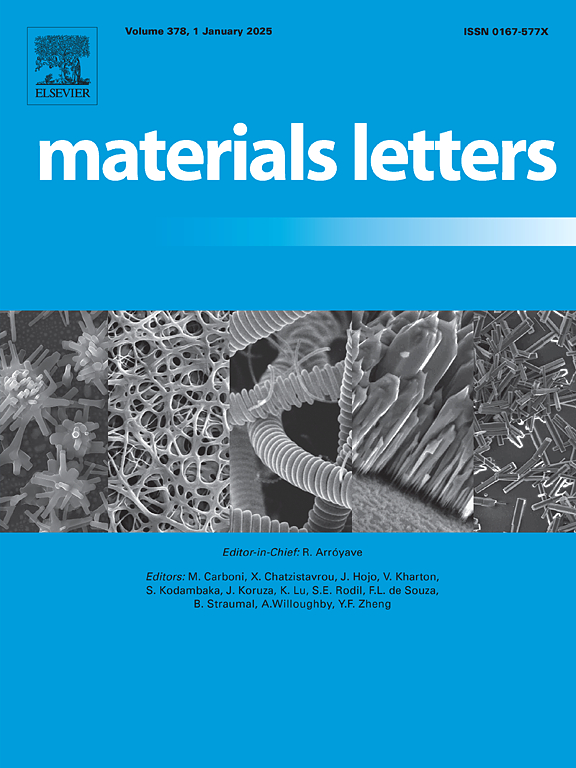Fabrication of electrospun Bi-doped TiO2 nanofibers with high photocatalytic activity
IF 2.7
4区 材料科学
Q3 MATERIALS SCIENCE, MULTIDISCIPLINARY
引用次数: 0
Abstract
Titanium dioxide (TiO2) has been widely used as a photocatalytic material due to its high durability, chemical stability, and non-toxic properties. However, the commercialization of TiO2 photocatalysts confronts challenges due to the wide bandgap and rapid electron-hole recombination. Various methods, such as surface modification, heterojunction formation, and doping, aim to overcome these limitations. In this study, one-dimensional Bi-doped TiO2 nanofibers were prepared using an electrospinning process, and the dopant concentration was controlled through the composition of a precursor sol solution. Mixtures of titanium tetraisopropoxide and bismuth nitrate dissolved in ethanol were used as the precursor. The prepared nanofibers were characterized using FE-SEM, XRD, XPS and Raman spectroscopy and FT-IR. The microstructure and surface morphology showed uniform fibrous structure, and doping of Bi into the TiO2 matrix was confirmed. The crystal structure was indexed to a mixed phase of anatase and rutile. The average diameter of the samples was 623 nm. To evaluate photocatalytic efficiency, a photodegradation test was carried out on acid orange 7 (AO7) and methylene blue (MB) using Bi-doped TiO2 nanofibers. Under UV irradiation, the Bi-doped TiO2 nanofibers showed better AO7 degradation activity compared to the pure TiO2 nanofibers, but photodegrading methylene blue was less effective. The highest photodegradation percentages were 62.48 % for TNF3 in AO7 and 97.10 % for TNF0 in MB.
高光催化活性双掺杂TiO2纳米纤维的制备
二氧化钛(TiO2)由于其高耐久性、化学稳定性和无毒等特性而被广泛用作光催化材料。然而,TiO2光催化剂的广泛禁带和快速的电子-空穴复合使其商业化面临挑战。各种方法,如表面改性、异质结形成和掺杂,旨在克服这些限制。本研究采用静电纺丝工艺制备了一维双掺杂TiO2纳米纤维,并通过前驱体溶胶溶液的组成来控制掺杂浓度。以四异丙醇钛和硝酸铋的混合物为前驱体。采用FE-SEM、XRD、XPS、拉曼光谱和FT-IR对所制备的纳米纤维进行了表征。微观结构和表面形貌表现为均匀的纤维状结构,证实了铋在TiO2基体中掺杂。晶体结构为锐钛矿和金红石的混合相。样品的平均直径为623 nm。为了评价光催化效率,采用双掺杂TiO2纳米纤维对酸性橙7 (AO7)和亚甲基蓝(MB)进行了光降解试验。在紫外照射下,双掺杂TiO2纳米纤维对AO7的降解活性优于纯TiO2纳米纤维,但光降解亚甲基蓝的效果较差。AO7中TNF3的光降解率最高为62.48%,MB中TNF0的光降解率最高为97.10%。
本文章由计算机程序翻译,如有差异,请以英文原文为准。
求助全文
约1分钟内获得全文
求助全文
来源期刊

Materials Letters
工程技术-材料科学:综合
CiteScore
5.60
自引率
3.30%
发文量
1948
审稿时长
50 days
期刊介绍:
Materials Letters has an open access mirror journal Materials Letters: X, sharing the same aims and scope, editorial team, submission system and rigorous peer review.
Materials Letters is dedicated to publishing novel, cutting edge reports of broad interest to the materials community. The journal provides a forum for materials scientists and engineers, physicists, and chemists to rapidly communicate on the most important topics in the field of materials.
Contributions include, but are not limited to, a variety of topics such as:
• Materials - Metals and alloys, amorphous solids, ceramics, composites, polymers, semiconductors
• Applications - Structural, opto-electronic, magnetic, medical, MEMS, sensors, smart
• Characterization - Analytical, microscopy, scanning probes, nanoscopic, optical, electrical, magnetic, acoustic, spectroscopic, diffraction
• Novel Materials - Micro and nanostructures (nanowires, nanotubes, nanoparticles), nanocomposites, thin films, superlattices, quantum dots.
• Processing - Crystal growth, thin film processing, sol-gel processing, mechanical processing, assembly, nanocrystalline processing.
• Properties - Mechanical, magnetic, optical, electrical, ferroelectric, thermal, interfacial, transport, thermodynamic
• Synthesis - Quenching, solid state, solidification, solution synthesis, vapor deposition, high pressure, explosive
 求助内容:
求助内容: 应助结果提醒方式:
应助结果提醒方式:


